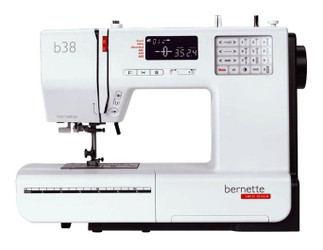What Is the Easiest Sewing Machine to Use?
19th Sep 2024
What Is the Easiest Sewing Machine to Use?
Sewing machines have evolved over the years from simple straight stitching to computerized models with automated functions such as multiple built-in stitches, feed dogs and one-step buttonhole options.
Shopping for a sewing machine can be overwhelming for beginners because of the wide range of features and brands. It helps to know which features can make a machine easy to use, especially if sewing is a new hobby to you. Ask any intermediate or expert sewer about the frustration of using an antiquated buttonhole system, and you’ll know what we’re talking about.
The easiest sewing machine as a result may not necessarily be the cheapest, but it can be at a price point that any sewer can afford. In fact, choosing a sewing machine based only on price can cost you more in the long run when compared to reputable brands that can offer durability and a limited warranty for as long as 25 years.
- Balancing cost and simplicity
- Mechanical sewing machines vs. computerized sewing machines
- Big features come in small sewing machines
- Tailoring your sewing machine to your needs
Balancing Cost and Simplicity
Some sewing machines have a straightforward design that
makes learning easier and not too overwhelming. There are several sewing machine brands such as Janome, Necchi, Juki and
Bernette on the market that have affordable sewing machines s
Sewing machines are also an investment and are meant to last you a long time with proper maintenance and care. So while you’re considering cost, remember that it is best to get a good quality machine right from the start. You can get both quality and affordability without breaking the bank!
Mechanical Sewing Machines vs. Computerized Sewing Machines


Modern sewing machines can either be mechanical or computerized. Whether you choose mechanical or computerized, here are the many features available on both types of sewing machines so you can weigh the options between the two.
Mechanical sewing machines have more hand control over the machine. With modern mechanical sewing machines, you use dials and knobs to switch the stitch design. Additionally, they have fewer settings than computerized machines but are easier to use and simpler to learn.
Computerized sewing machines h
Many experienced sewers recommend mechanical sewing machines f
Starting with the basics is always a good start, and the more you practice, the better you will be able to decide on your next sewing machine upgrade.
Big Features Come in Small Sewing Machines
The larger the sewing machine, the more likely it’s not going to be the easiest for a beginner sewer to use. This is because most sewing machines that are large tend to be made for industrial or more complex sewing needs and can even take up whole counters or rooms!
Earlier, we discussed domestic sewing machines that are computerized versus mechanical. Another choice to consider could be a mini sewing machine. Mini or portable sewing machines are essentially the same as standard-sized sewing machines but compact in size. They tend to have a simpler design but are not short on features.
Mini sewing machines are a great choice for beginner sewers that want to learn the basics. They can be easily transported for travel or on-the-go use. These machines are also a great option for younger sewers that want to get started in this hobby and might find a larger machine intimidating.
Tailoring Your Sewing Machine to Your Needs
Now that you understand some basics of what makes a sewing machine easy for beginners, you will want to consider the many feature options and benefits you need. Here are some features you can look for in a sewing machine. Depending on what type of sewing projects you have in mind, you might need some of these time-saving features to ensure that your new machine is truly easy for you to use.
Automatic needle threading: The arduous task of threading a needle manually is no easy feat. This feature could save minutes or maybe even hours of frustration.
Free arm: Just as a narrow-ended ironing board helps you press a shirt sleeve, a free arm helps you sew one. The narrower the end of the surface, the easier it is to manipulate the fabric, so look for this feature if you plan to do tailoring.
One-step buttonhole: Adding the perfect buttonhole to a garment is simple on a sewing machine with this feature.
LED-lit work area: Built-in LED lighting helps illuminate your sewing surface so that every stitch and pattern can be perfected.
Drop-in bobbin: The bobbin is the spool of thread that is loaded beneath the sewing surface and is fed into the needle threader. A drop-in bobbin allows you to simply drop in the new thread and easily switch it out for different thread colors and stitches through a sliding door.
Finding Your Easiest Sewing Machine to Use
Sewing machines are not one-size-fits-all and are built based on the needs of the sewer’s level, features, and projects. With so many types of sewing machines, sizes, brands and models on the market, we hope this list will help you navigate to the easiest sewing machine for you!
Now that you've narrowed down some of the features you need, all that's left is to find the machine that’s right for you. Each of our machines comes with a generous warranty fulfilled directly by Premier Stitching, so you don’t need to worry about dealing with multiple parties should any malfunctions occur. You can also get free shipping on all of our machines.



